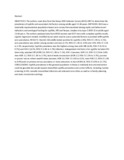Epidemiology of syphilis in Kenya: results from a nationally representative serological survey.

View/
Date
2011Author
Otieno-Nyunya, B
Bennett, E
Bunnell, R
Dadabhai, S
Gichangi, A A
Mugo, N
Wanyungu, J
Baya, I
Kaiser, R
Type
ArticleLanguage
enMetadata
Show full item recordAbstract
OBJECTIVES:
The authors used data from the Kenya AIDS Indicator Survey (KAIS) 2007 to determine the prevalence of syphilis and associated risk factors among adults aged 15-64 years.
METHODS:
KAIS was a nationally representative population-based sero-survey that examined demographic and behavioural indicators and serological testing for syphilis, HIV and herpes simplex virus type 2 (HSV-2) in adults aged 15-64 years. The authors analysed data from 8935 women and 6727 men with complete syphilis results. Logistic regression models stratified by sex were used to assess potential factors associated with syphilis sero-prevalence.
RESULTS:
Overall, 262 adults tested positive for syphilis (1.8%, 95% CI 1.5% to 2.1%); sero-prevalence was similar among women and men (1.7%, 95% CI 1.3% to 2.0% and 1.9%, 95% CI 1.5% to 2.3%, respectively). Syphilis prevalence was the highest among men with HIV (6.4%, 95% CI 3.1% to 9.7%) and HSV-2 (4.5%, 95% CI 3.4% to 5.7%) infection. Independent risk factors for syphilis included HIV (men only, adjusted OR (AOR) 3.4, 95% CI 1.6% to 7.1%), HSV-2 (women, AOR 3.5, 95% CI 2.1% to 5.8%; men AOR 2.2, 95% CI 1.3% to 3.7%), lack of male circumcision (AOR 2.2, 95% CI 1.3% to 3.7%), poorest or poorer versus richest wealth index (women, AOR 2.0, 95% CI 1.0% to 4.2%; men AOR 2.5, 95% CI 1.4% to 4.9%) and no primary versus secondary or more education in men (AOR 4.8, 95% CI 2.0% to 11.7%).
CONCLUSIONS:
Syphilis prevalence in the general population in Kenya is relatively low and eradication could be possible but would require intensified syphilis prevention and control efforts, including routine screening in HIV, sexually transmitted infection and antenatal care clinics as well as in family planning and male circumcision settings.
Citation
Epidemiology of syphilis in Kenya: results from a nationally representative serological survey. Otieno-Nyunya B, Bennett E, Bunnell R, Dadabhai S, Gichangi A A, Mugo N, Wanyungu J, Baya I, Kaiser R; Kenya AIDS Indicator Survey Study Team. Sex Transm Infect. 2011 Oct;87(6):521-5. doi: 10.1136/sextrans-2011-050026.Publisher
Center for Global Health, Division of Global HIV/AIDS, Centers for Disease Control and Prevention Kenya, Village Market Nairobi, Kenya.
